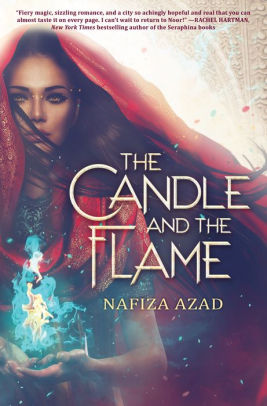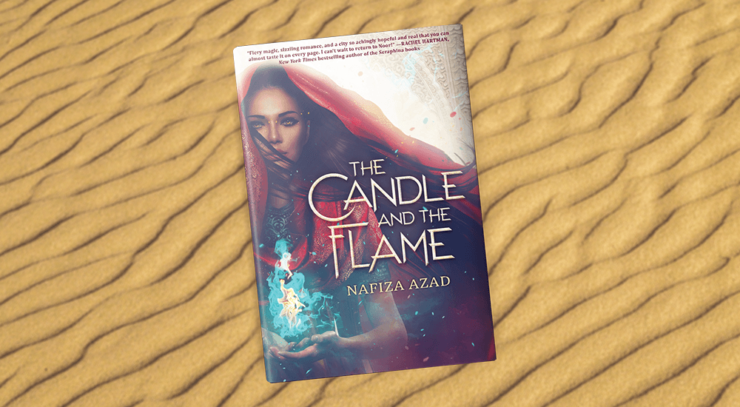Fourteen years ago, a heartbroken Ifrit (djinn drawn to order) found a dying girl in the desert and saved the child’s life by surrendering hers. Eight years ago a gang of Shayateen (djinn draw to chaos) attacked the city of Noor and slaughtered thousands, all but two young girls and an old woman. Today, Noor is thriving once more, thanks in no small part to an alliance made between humans and Ifrit, but its future is uncertain. Citizens are being attacked by Shayateen and ghuls (undead monsters) and a rebellion is forming in the rest of the kingdom of Qirat.
In the middle of all this is Fatima, one of the three survivors. After witnessing a terrible, tragic death, she finds herself a human teenager with dangerous Ifrit powers. An Ifrit emissary pulls her into the intrigue at the maharajah’s court and soon she is the only thing standing in the way of the destruction of Qirat. With her new abilities Fatima must protect her fractured family at all costs, even if it means killing her enemies. But she isn’t the only one coming into newfound power. A princess, a sister, and a concubine’s daughter must rise above the low expectations set by the men around them and become the powerful women they truly are.
One of the first things readers who aren’t Muslim or who don’t speak Hindi, Urdu, Punjabi, or Arabic will notice are a lot of unfamiliar words and customs. I point that out not to deride Nafiza Azad’s authorial choices but to celebrate them. Yes, Azad uses a lot of words and titles that non-Muslims don’t know, but there are just enough context clues to get the basic meaning of most of them. Azad has helpfully included a detailed glossary in the back of the book, and I enjoyed looking up words that were new to me; knowing the definitions helped me engage in the story in a more meaningful way. Azad’s choice to include a more extensive vocabulary brings the novel to life and adds another layer of truth to the setting of a medieval Southeast Asian city on the Silk Road trade route.
And while there are a lot of cultural details in The Candle and the Flame, I also understand that teaching me everything there is to know about Islamic society isn’t Azad’s goal. Nor should it be. She doesn’t need to explain every little thing to me or walk me through detailed descriptions of traditions and customs. All she needs to do is tell her story in the best way she can, and I think she has.
For the most part, The Candle and the Flame is character driven; much of the action is reserved for the last 100 or so pages. While all that character focus is necessary for the action to make sense, it also makes the novel rather lopsided. It takes a long while for the plot to kick in, and the subplots don’t become obvious until right before they peak. Because there are so many characters and each one has a crucial role to play in the final act, there are a lot of action set pieces. I wish Azad spent a little more time with the specifics at the end instead of skipping huge chunks of time and having characters give us the bullet points of what they did. But even with the rush job, the resolution works overall because we’ve spent so much time with each character POV.
The cast of characters is split pretty evenly between men and women, but the range of personalities is vastly different. Men are either noble, monstrous, or nondescript. The good guys are almost too good – they self-sacrifice, defer to women in everything, and always have pure intentions even when they make mistakes – and the bad guys are unrepentantly vile and disgustingly sexist. The few who fall into neither category get so little personality definition that they may as well be cardboard cutouts.
Buy the Book


The Candle and the Flame
Women, on the other hand, come in a endless varieties. Every single woman who appears in The Candle and the Flame, no matter how brief or insignificant her role, is a living, breathing person with a rich interior life. And each one shatters stereotypes and tropes. Her characters aren’t just the princess, the Chosen One, the put upon sister, the heartless mother, the obedient wife. Like their names, they each carry multiple characteristics within them, some complementary, some contradictory. Their past experiences and future dreams shape their present choices and they rarely do what’s expected. There’s even a queer character – she doesn’t use that exact term, but she does say she isn’t romantically attracted to men. I can’t remember the last time I read YA fantasy with such complex character development. To be honest, I’m actually ok with men getting the short shrift and women getting all the exposition. Fiction often does the opposite, and even young adult fantasy tends to give dimension and depth to only a few characters with the others remaining shallow and hollow.
The Ifrit live in a matriarchy and humans in a patriarchy. Yet regardless of which gender has dominance, bad men will always find a way to inflict harm. Bad men proliferate because those in power placate or dismiss their predatory behaviors instead of curbing them. It’s less about who holds control and more about how that control is used, both to protect and to destroy.
In Qirat, men rule the land but women have power of their own and aren’t afraid to use it. We see how women carve out their own spaces and how Islamic culture protects and reinforces those spaces to give them more freedom than I think many non Muslims believe they have. Violence and oppression against women isn’t caused by Islam itself but by bad men who have rejected the respect their cultural traditions demand. That should be obvious, but since Westerners seem so determined to embrace Islamophobia I feel like it needs to be said. Azad didn’t come to play with her depictions of womanhood. She pushes back against both the patriarchy within Muslim society and the stereotypes many Westerners have of Muslim society.
The Candle and the Flame burns bright and hot, a bonfire of nuanced women, vivid settings, and deep emotions. This is stellar work for a debut author. If this is what Nafiza Azad is capable off right out of the gate, she has an incredible career ahead of her. And I’ll be there for all of it.
The Candle and the Flame is available from Scholastic.
Alex Brown is a high school librarian by day, local historian by night, author and writer by passion, and an ace/aro Black woman all the time. Keep up with her on Twitter and Insta, or follow along with her reading adventures on her blog.










